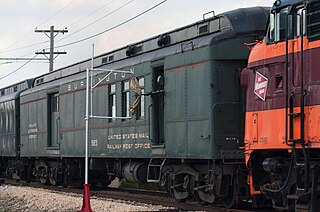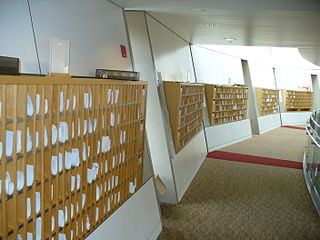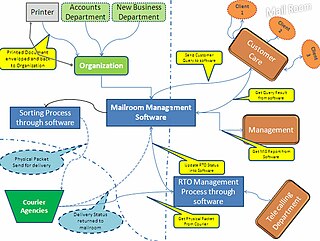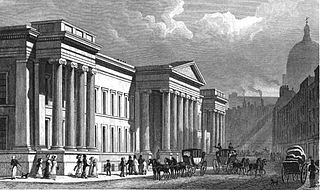
The United States Postal Service (USPS), also known as the Post Office, U.S. Mail, or Postal Service, is an independent agency of the executive branch of the United States federal government responsible for providing postal service in the United States, its insular areas, and its associated states. It is one of the few government agencies explicitly authorized by the Constitution of the United States. As of 2023, the USPS has 525,469 career employees and 114,623 non-career employees.

Postal codes used in the United Kingdom, British Overseas Territories and Crown dependencies are known as postcodes. They are alphanumeric and were adopted nationally between 11 October 1959 and 1974, having been devised by the General Post Office . The system uses alphanumeric codes to designate geographic areas. A full postcode, also known as a "postcode unit," identifies a group of addresses or a major delivery point. It consists of an outward code and inward code. The outward code indicates the area and district, while the inward code specifies the sector and delivery point, typically encompassing about 15 addresses.

An office is a space where the employees of an organization perform administrative work in order to support and realize the various goals of the organization. The word "office" may also denote a position within an organization with specific duties attached to it ; the latter is an earlier usage, as "office" originally referred to the location of one's duty. In its adjective form, the term "office" may refer to business-related tasks. In law, a company or organization has offices in any place where it has an official presence, even if that presence consists of a storage silo, for example, instead of a more traditional establishment with a desk and chair. An office is also an architectural and design phenomenon, including small offices, such as a bench in the corner of a small business or a room in someone's home, entire floors of buildings, and massive buildings dedicated entirely to one company. In modern terms, an office is usually the location where white-collar workers carry out their functions.
A newsletter is a printed or electronic report containing news concerning the activities of a business or an organization that is sent to its members, customers, employees or other subscribers. Newsletters generally contain one main topic of interest to its recipients. A newsletter may be considered grey literature. E-newsletters are delivered electronically via e-mail and can be viewed as spamming if e-mail marketing is sent unsolicited.
The Postcode Address File (PAF) is a database that contains all known "delivery points" and postcodes in the United Kingdom. The PAF is a collection of over 29 million Royal Mail postal addresses and 1.8 million postcodes. It is available in a variety of formats including FTP download and compact disc, and was previously available as digital audio tape. As owner of the PAF, Royal Mail is required by section 116 of the Postal Services Act 2000 to maintain the data and make it available on reasonable terms. A charge is made for lookup services or wholesale supply of PAF data. Charges are regulated by Ofcom. It includes small user residential, small user organisation and large user organisation details. There have been requests as part of the Open Data campaign for the PAF to be released by the government free of charge.

In Canada and the United States, a railway post office, commonly abbreviated as RPO, was a railroad car that was normally operated in passenger service and used specifically for staff to sort mail en route, in order to speed delivery. The RPO was staffed by highly trained Railway Mail Service postal clerks, and was off-limits to the passengers on the train.
The front office is the part of a company that comes in contact with clients, such as the marketing, sales, and service departments. The term has more specific meaning in different industries.

In the airline industry, a baggage handler is a person who loads and unloads baggage, and other cargo for transport via aircraft. With most airlines, the formal job title is "fleet service agent/clerk", though the position is commonly known amongst airline employees as a "ramp agent", due to the job's location on the airport ramp (tarmac).

A pigeon-hole messagebox is an internal mail system commonly used for communication in organisations, workplaces and educational institutes in the United Kingdom and other countries. Documents and messages are placed in a person's pigeon-hole for them to collect; they can reply by putting a response inside the sender's pigeon-hole.

Pranknet, also known as Prank University, was an anonymous prank calling virtual community that was involved in a string of malicious pranks and instances of telephone harassment, especially during 2009–2011. Their pranks were coordinated through an online chat room, and convinced others to cause damage to hotels and fast food restaurants of more than $60,000. The group was founded by a man who later referred to himself as "Dex1x1", later identified as a Canadian named Tariq Malik. The group has been linked to nearly 60 separate incidents.

Digital mailroom is the automation of incoming mail processes. Using document scanning and document capture technologies, companies can digitise incoming mail and automate the classification and distribution of mail within the organization. Both paper and electronic mail (email) can be managed through the same process allowing companies to standardize their internal mail distribution procedures and adhere to company compliance policies.

A mailroom (US) or post room (UK) is a room in which incoming and outgoing mail is processed and sorted. Mailrooms are commonly found in schools, offices, apartment buildings, and the generic post office. A person who works in a mailroom is known as a mailroom clerk or mailboy and the head person is called the postmaster. The mailroom is responsible for a company's incoming and outgoing mail. A mailroom clerk prepares outgoing mail and packages prior to their being sent out via the post office or other carrier.
A Nixie is a name given by the United States Postal Service to a piece of mail which is undeliverable as addressed. It is derived from "nix", English slang for the German nichts ("nothing"), and "-ie", an item or a thing.

The General Post Office in St. Martin's Le Grand was the main post office for London between 1829 and 1910, the headquarters of the General Post Office of the United Kingdom of Great Britain and Ireland, and England's first purpose-built post office.

Package tracking or package logging is the process of localizing shipping containers, mail and parcel post at different points of time during sorting, warehousing, and package delivery to verify their provenance and to predict and aid delivery.
The newspaper production process begins with gathering news stories, articles, opinions, advertorials and advertisements to printing and folding of the hard copy. Usually, the news items are printed onto newsprint. The whole production process can be divided into four parts: Content gathering, Pre-press, Press and Post-press. The term production process should not be confused with manufacture as Production process is the stage at which many taxes are levied and collected in almost all countries. Manufacture is the stage at which the product becomes marketable and therefore the term also includes the stages of packaging and packing.

Ayr Post Office is a heritage-listed post office at 155 Queen Street, Ayr, Shire of Burdekin, Queensland, Australia. It was designed by the Commonwealth Department of Interior and was built in 1936. It was added to the Australian Commonwealth Heritage List on 22 August 2012.

Bowen Post Office is a heritage-listed post office at 46 Herbert Street, Bowen, Queensland, Australia. It was designed by the Commonwealth Department of the Interior and constructed in 1936. It was added to the Australian Commonwealth Heritage List on 8 November 2011.

Ingham Post Office is a heritage-listed post office at 15 Lannercost Street, Ingham, Shire of Hinchinbrook, Queensland, Australia. It was built in 1935. It was added to the Australian Commonwealth Heritage List on 22 August 2012.

Leongatha Post Office is a heritage-listed post office and former telegraph office at 4 McCartin Street, Leongatha, Victoria, Australia. It was designed by J. B. Cohen of the state Public Works Department for the Commonwealth Government. It was added to the Australian Commonwealth Heritage List on 22 June 2004.

















